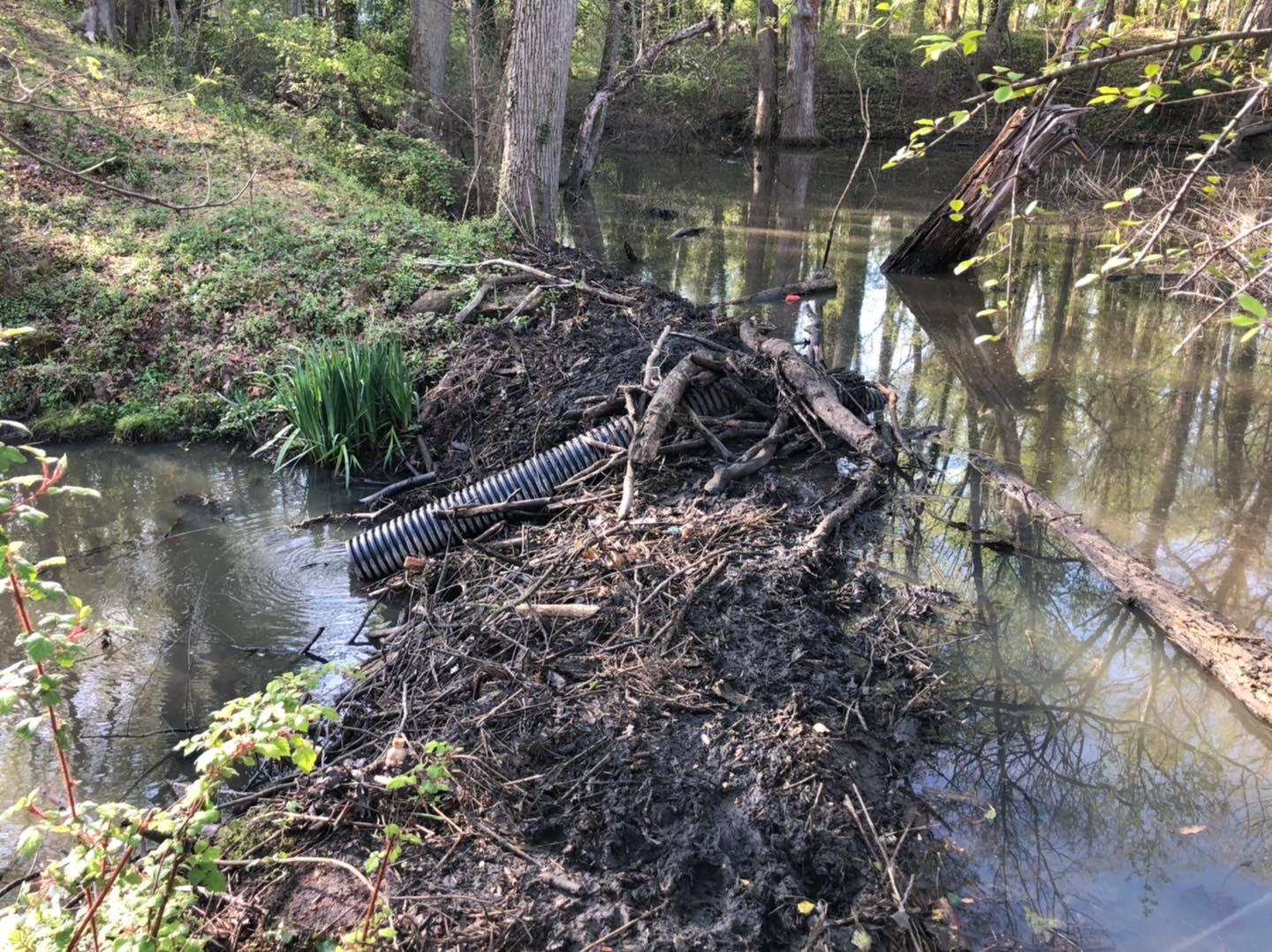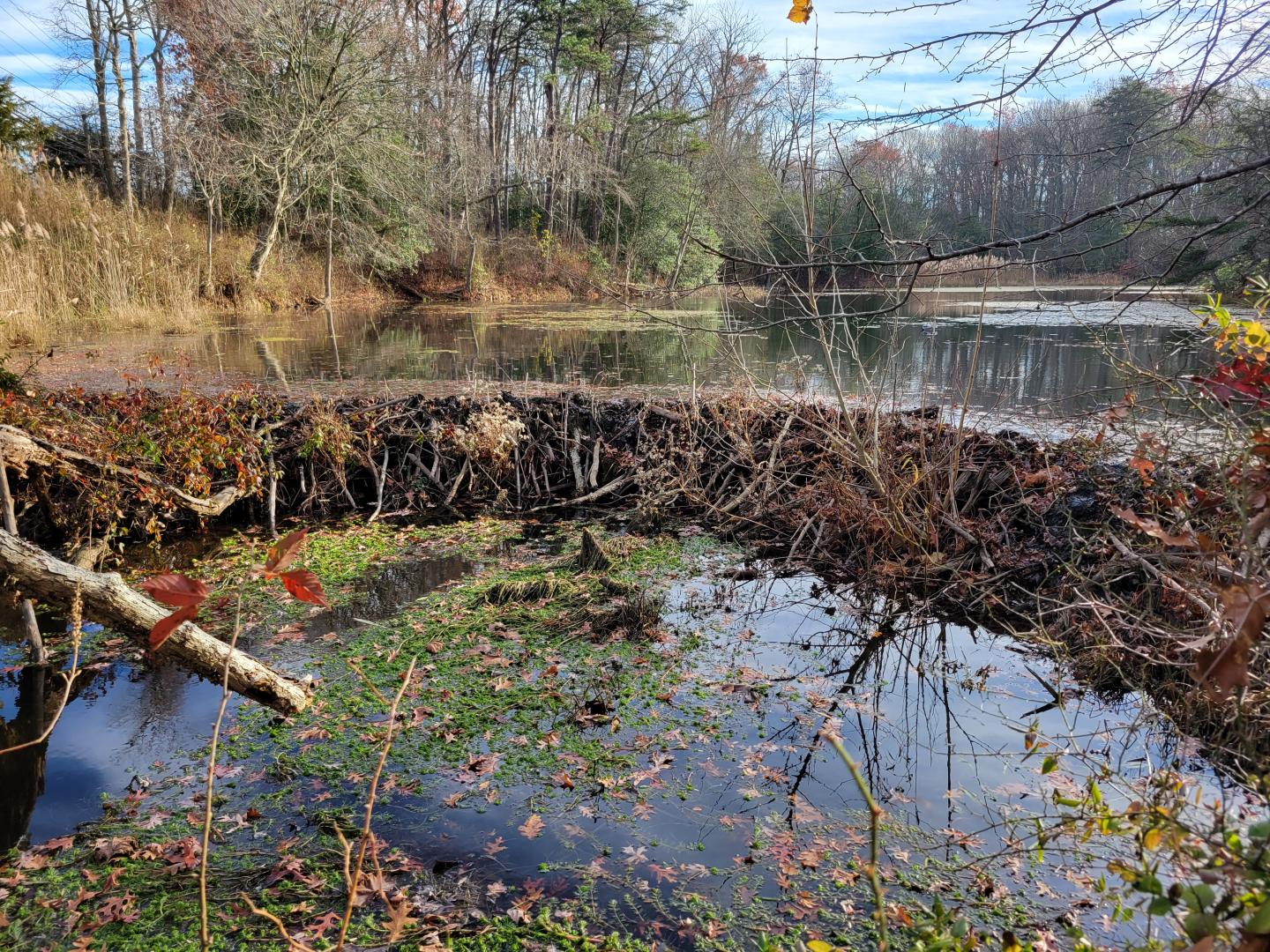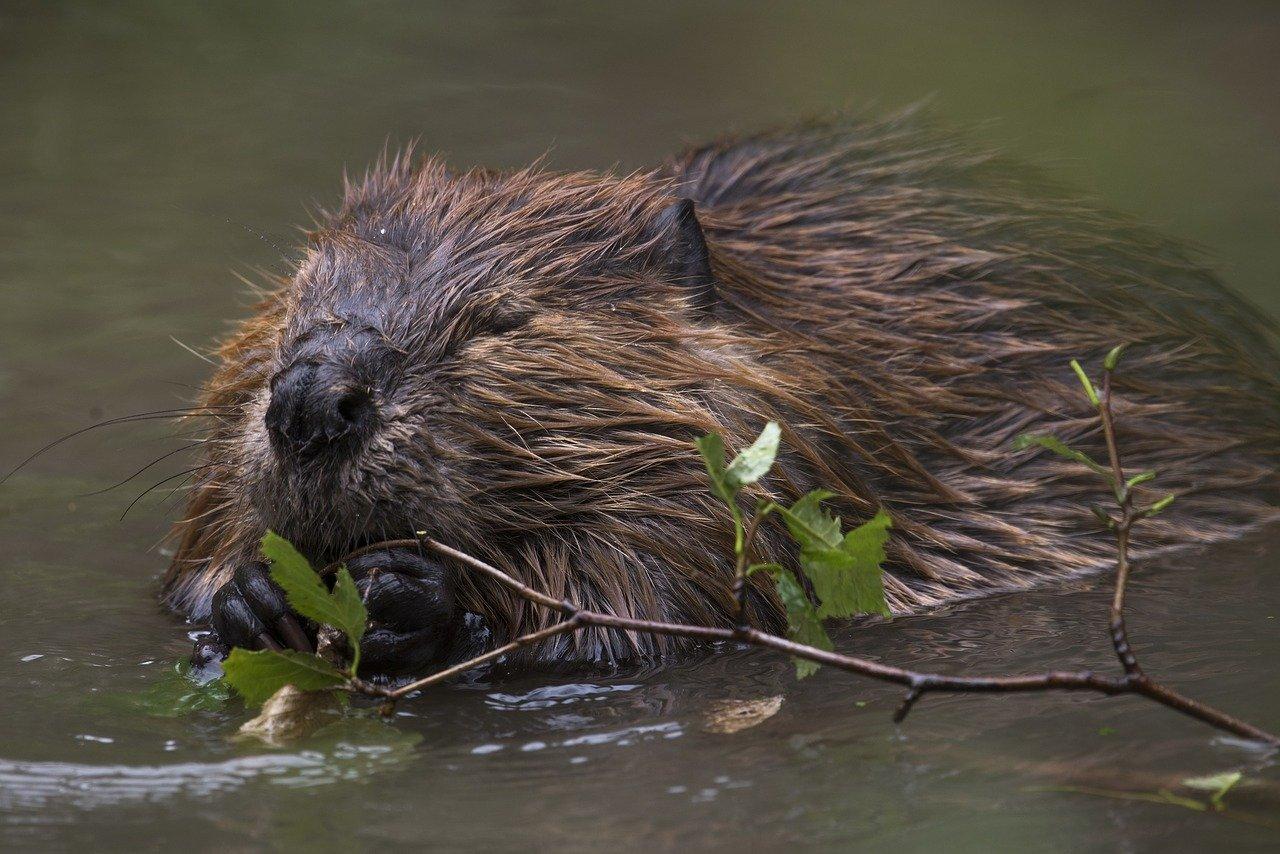Meet your neighbor, the beaver!
- They are famous for their dam-building skills used to create their own permanent pond by damming up streams. The beaver is making a comeback in many areas where they have been absent for decades because of development. Beavers feed at night primarily on woody plants although they will also eat herbaceous plants and aquatic plants.
- Beavers live near rivers, streams, ponds, small lakes, and marshes. Beavers cut down small-medium trees to dam up streams and rivers to create ponds. One beaver can cut down 216 trees in a year. Beavers live in lodges which include a feeding den, a resting den, a source of fresh air, and two underwater entrance tunnels, which allow for a means of escape if a predator enters the lodge.
- Beavers, just like people, change their habitat to suit their needs. When beavers build a dam and change a portion of fast-moving stream into a pond, they not only create their own habitat but provide habitat for many other species. Beaver ponds are deep enough to prevent water from freezing to the bottom in winter. This provides an important winter habitat for many species of fish, reptiles, and amphibians. Beavers also create wetland habitats for herons, frogs, river otters, mink, muskrats, raccoons, amphibians, waterfowl, and many species of plants.
- Beavers help to protect water quality by slowing stream flows. By creating low dams in streams, flows entering beaver ponds slow down, enhancing natural processes that tend to mediate nitrogen and sediment levels in watersheds where they occur, helping clean the Chesapeake Bay.
Beaver FAQs
Beavers thrive in connected floodplain ecosystems. Once nearly extinct due to heavy trapping for the fur trade, beavers are now found all over Maryland and are making a strong comeback across their historical range. Beavers often return to stream reaches restored by the County and others. Reconnecting flows from the watershed to the stream’s floodplain along with the restoration of natural vegetative communities provide ideal conditions for beavers to return to these areas.
- Winter: In the winter months, particularly when ponds are frozen over, beavers spend most of their time in the water and in their lodges. Mating also occurs in winter.
- Spring & Early Summer: In late winter / early spring, beavers emerge to feed on nearby woody vegetation. As new vegetation emerges, beavers expand their foraging range and transition to a diet largely consisting of grasses, forbs, and aquatic plants. During spring and early summer, beavers are busy repairing existing dams or building new ones. At this time, beaver kits are also being born.
- Late Summer & Fall: In late summer and early fall, tree felling greatly increases as beavers fill their food caches and repair existing lodges (or build new ones) in preparation for winter.
Dams help to hide from predators and allow easy access to food. Beavers build dams to create ponds to give them a place to live that is safe from predators and allows them easy access to food. Beavers are stimulated to build dams by the sound and feel of flowing water.
Beavers are ecosystem engineers! Beavers are known as a “keystone species,” which are species whose behaviors and activities have a disproportionate and profound impact on the surrounding ecosystem, such that many other species depend upon the conditions created by their activities Beaver thin forests to create dams, which trap sediment, enhance stream nutrient processing, increase groundwater recharge, and create diverse wetland and floodplain habitats that are home to numerous plants and animals.
Yards near the water will be wetter and trees might be taken down if not protected. As beavers construct dams, you might notice water levels start to rise, which might mean parts of your backyard become a little wetter. If you have trees on your property that are close to the water, you might notice beavers chewing on and taking down trees for food and dam construction.
Fencing and taste deterrents have been found to be the most effective. There are a few methods you can use to prevent beavers from removing or damaging trees on your property. A fence or even a short barrier (beavers are not good climbers) around your yard will prevent beavers from entering your yard. Individual trees can be protected using 4-ft tall wire fencing wrapped around the base of the tree (be sure to leave a 3-5” gap between the fencing and the tree).
A mixture of latex paint and sand can also be applied to the bottom 4-ft of the tree to deter chewing (this will have to be re-applied annually). Taste deterrents can be purchased commercially, or made at home. For example, infusing vegetable or mineral oil with cayenne pepper and applying it to the base of the tree can effectively deter beavers, but requires reapplication 2-3 times annually.
How To Protect Trees from Beaver Chewing (source: The Beaver Institute)
In Maryland, beavers may only be trapped by licensed Nuisance Wildlife Control Operators at any time of the year, or by licensed trappers during the open season for trapping beaver. Anne Arundel County Animal Control does not provide nuisance wildlife trapping services. However, the Maryland Department of Natural Resources works with many licensed and approved wildlife contractors to serve County residents.
The County can help with identifying a licensed contractor for relocation, but it can be costly and ultimately ineffective. Removal of beavers is ineffective because if the habitat is suitable and food sources are sufficient, new beavers will just replace the trapped individuals. This creates a scenario in which beaver removal becomes a perpetual (and costly) activity.
No, the beaver will likely just rebuild the dam. Removing or destroying beaver dams and beaver lodges will not cause beavers to abandon the site. In fact, it will only motivate them to repair or rebuild their structures, resulting in more intensive tree felling.
Yes, to an extent. Beavers like to aim trees toward the water. A ten-year study revealed that over 70 percent of the time, beavers are successful in felling trees in the direction of the water/their lodge (the preferred direction for both beavers and homeowners).
Yes, it appears so! Beavers in our region tend to prefer willow and alder. In our region, beavers’ favorite snacks are willow and alder. A variety of other tree and shrub species make up their diet as well, but they tend to favor fast-growing species that grow close to the water's edge. Beavers’ diets also change seasonally. In the spring, beaver diets consist mainly of grasses, forbs, and tubers. As the year progresses, however, their diet shifts more and more towards leaves, twigs, and the inner bark of trees.
If you have an immediate concern regarding tree damage and/or flooding in your yard due to beaver activity, give us a call or send us an email to learn more about actions you can take!
For emergency assistance relating to flooding or public safety, please contact your local County Road Operations Maintenance District. Find your Maintenance District here. Non-emergency concerns relating to County infrastructure can be reported online via SeeClickFix or by dialing 311.
For non-emergency assistance, please refer all general questions or concerns relating to coexisting with beavers to our Bureau’s Education & Outreach Coordinator, Sally Albright, who can be reached at 410-222-0136 or pwalbr00@aacounty.org.
Living with Beavers in Anne Arundel County
Best recommended practices for working in concert with native beavers will vary case by case and often require the implementation of creative and innovative methods. The project below offers a local example of human-beaver coexistence:

Pond Levelers at North Cypress Branch
Why was North Cypress Branch restored?
Restoration efforts were initiated to maintain boating access in the tidal reaches of Cypress Creek and minimize future dredging needs. Stream networks are profoundly influenced by activities occurring on the lands that drain into these systems. In recognition of this connectivity, in the late 1990s, the County began to adopt a more holistic approach to watershed management across all County watersheds.
One aspect of this realignment concerned the approach to maintaining recreational boating access to tidal creeks like Cypress Branch. A regulatory requirement for continued dredging from these places is to determine where in the stream network sediment is generated and to take actions to arrest its delivery into areas downstream, thus reducing the frequency of dredging.
This portion of Cypress Creek was identified in the early 2000s as one of four reaches contributing excess sediment to the navigable, tidal portions of Cypress Creek. This project is an attempt to reduce sediment in compliance with these requirements.
What was done at North Cypress Branch to manage human-beaver coexistence?
At the North Cypress Branch pond, the County contracted Ecotone, Inc. to install two (2) pond leveler flow devices to allow water to flow downstream underneath a dam on the downstream end of the pond. What is a flow device?
The County routinely monitors the pond leveler intakes (mesh metal box in the middle of the pond) for potential debris buildup. If you are concerned that a debris jam forming at the intake that might be prohibiting downstream flow, please contact BWPR at 410-222-4240 to initiate a site inspection.
Learn more about the restoration project:
- North Cypress Branch was awarded "Best Stream Restoration" in the Chesapeake Network's Best Urban BMP of the Bay Awards in 2017
- BayLand Consultants & Designers, Inc., contracted during the design and planning phase, published a webpage about the North Cypress Branch project here.
- Resource Environmental Solutions, LLC (RES), contracted for the construction of the stream restoration project, published a webpage about the North Cypress Branch project here.
Additional resources:
- Leave it to Beavers - A guide for children on the benefits of beaver
- Benefits of Beaver Ponds and Lodges
- The Ecological Benefits of Beavers - Various Resources
- The Busy, Beneficial Beaver
- How Beavers Can Save Us From Ourselves


